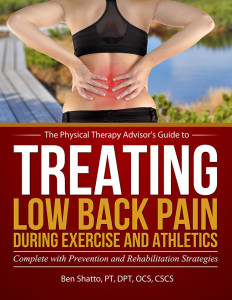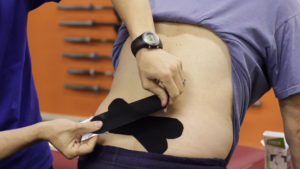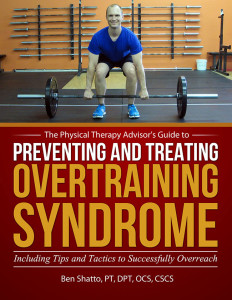We all work hard exercising and training for the next race, game, and/or competition. We invest hundreds and thousands of dollars and hours upon hours training for our sport or activity. We learn everything we can about our sport. We buy the newest gear and fitness apps. We invest in the newest and greatest training plans and programs. Yet, we often fail to address the obvious. The best training plan in the world won’t do us much good if we’re unable to implement that plan due to pain and/or injury. Many of us just accept occasional episodes of low back pain (LBP) as a normal part of life, but these episodes of LBP can have both devastating monetary and training consequences.

What if you could prevent injury and the loss of training days? What if you could prevent costly physician visits? What if you could spend your money on the best fitness and training programs and gear instead of on pain relief gels, oils, and scams?
The following list of potential risk factors for LBP addresses how you can be proactive in maintaining a healthy back. How many of the following 12 risk factors can you relate to?
12 Risk Factors for Low Back Pain:
- Smoking – Smoking is a major risk factor for low back pain (LBP). The chemicals in cigarette smoke affect both the lung’s ability to exchange oxygen and the body’s normal healing response. These chemicals alter the blood supply to the discs and other spinal structures which affects nutrient exchange and increases the risk of pain. Healing time for all medical conditions worsen with smoking. Although research is forthcoming, it’s likely that vaping also has a negative impact on healing and LBP. Anything that negatively affects optimal health will increase your risk of LBP and recovery from injury.
- Gender – This is an interesting one. It may relate to certain behaviors more than anatomical differences, but males have a higher risk of LBP. Females tend to experience more cervical or neck pain.
- Pregnancy – Pregnancy increases your risk for LBP due to structural changes as the baby develops and hormones change. The expectant mother releases relaxin, a hormone which loosens the whole body, to prepare for the baby’s delivery. Again, a risk worth taking! Most women can manage the pain by modifying posture and movements while learning techniques for self-management.
- Heredity – A family history of low back pain increases your risk. In some cases, this may be due to actual structural deformities which may be genetically linked. More commonly, it’s a learned behavior, such as chronic sitting and slouching (poor posture), that can lead to a higher risk of LBP.
- Prior Episodes of LBP – Once you have experienced LBP, you are more likely to have re-current episodes. This is typically due to not addressing the precipitating factors that led to the first episode of LBP. It’s also likely due to weakness in the deep multifidus muscles that help to support the spine and prevent shearing forces. This weakness can be addressed with proper physical therapy intervention. (Please refer to Why You Keep Hurting Your Back.)
- Lack of Exercise/Activity – A sedentary lifestyle will increase your risk for LBP. The spine is designed to work and move. In order for the spine to remain healthy, it requires exercise and movement.
- Too Much Sitting – Sitting for even a moderate amount of time not only affects your general health status in a negative way, but it also increases your risk for LBP. Sitting for more than 30 minutes at a time can increase your risk. Worse yet is sitting with poor posture or unsupported. Sitting on vibrating surfaces such as a heavy equipment operator will increase your risk further. Please refer to The #1 Way to Extend Your Life Span for the reasons why sitting has such a negative effect on your body.
- Poor Posture – In western culture, we spend most of our day sitting slouched or standing hunched over. This is an excellent way to increase your risk for LBP. It’s one of the major risk factors for disc herniation and development of spinal stenosis. Please refer to How to Improve Posture & Eliminate Pain for exercises that can help you to develop better posture and strength to eliminate back pain.
- Lack of Warm Up Before Exercise – This is a common mistake which can lead to injury. A proper warm up prior to an event or exercise session is critical for injury prevention and in order to achieve peak performance. A poor warm up affects your ability to get the most out of each training session. A warm up should consist of a cardiovascular component, a spine specific component, and a dynamic stretching routine of the actual exercises you will be performing to insure you’re ready for the movement. This is pertinent for any training session regardless of sport including weightlifting and running.
- Training when Exhausted – Allowing yourself to become over fatigued will increase your risk of all types of injury including LBP. This is a common problem among CrossFitters and anyone who trains at a very high intense level. Typically, this results in poor technique which further increases your risk. Combine poor technique with muscles which can no longer perform the proper movement pattern, and you’re likely to become injured.
- Poor Technique – Poor technique often occurs when performing exercises that are too advanced, with too much resistance, and/or when feeling exhausted. Performing unfamiliar lifting techniques or lifting too much weight will likely result in poor technique.
- Training Volume – Overtraining syndrome (OTS) can occur when you train too hard for too long. Your training plan should include scheduled rest and recovery cycles to allow your body the time to recover between competitions and high volume or intense training cycles. OTS definitely increases your risk of injury.
The key component to preventing reoccurring episodes of LBP is to address your risk factors. Determine what initially caused your LBP. If you are looking to finally prevent those reoccurring episodes of LBP that derail your training and/or are currently suffering from LBP, then Treating Low Back Pain (LBP) during Exercise and Athletics is the solution. This complete guide and system will help you to prevent, treat, and manage LBP so that you don’t have to waste any training days because of ineffective treatment measures.
Treating Low Back Pain during Exercise and Athletics

In this complete self-treatment package, Treating Low Back Pain (LBP) during Exercise and Athletics, I share very specific strategies for LBP prevention among athletes such as sport enthusiasts, CrossFitters, weightlifters, and runners. These principles are helpful for anyone participating in athletics as well as those implementing a healthy lifestyle. You’ll learn how to address specific causes of LBP as well as the best practices on how to prevent and self-treat when you experience an episode of LBP. In this step-by-step LBP rehabilitation guide (complete with photos and detailed exercise descriptions), you will discover how to implement prevention and rehabilitation strategies.

In this package, you get an in-depth look at treating LBP with a 7-part series of instructional videos in which I address low back pain prevention during exercise; specific warm ups for exercise and activities; what really is the “core” and why it matters; treatment techniques (including how to apply Kinesiological tape); and long term management strategies. This includes nearly 60 minutes of actionable advice to prevent and treat LBP as it relates to active individuals, sports (such as running), and athletics.

In this BONUS eBook, Preventing and Treating Overtraining Syndrome, I show you how to recognize the risk factors and symptoms of Overtraining Syndrome (OTS). You’ll learn how to utilize prevention strategies to help you develop a personal training strategy that will allow you to push past your limits and prior plateau points in order to reach a state of what is known as overreaching (your body’s ability to “supercompensate”). This will speed up your results, so that you can train harder and more effectively than ever before! In addition, learn how to use the foam roller (complete with photos and detailed exercise descriptions) as part of a health optimization program, recovery program, rest day or treatment modality.
